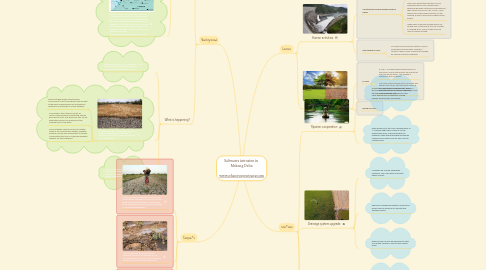
1. Background
1.1. What is it?
1.1.1. Saltwater intrusion (also known as seawater intrusion or salinity intrusion) is the movement of saltwater into freshwater aquifers, leading to groundwater quality degradation, including drinking water sources, and other consequences.
1.1.2. The figure above illustrates how the process of saltwater intrusion into an aquifer system can occur. Fresh groundwater discharging to the coast prevents the landward intrusion of saltwater. If too much freshwater is pumped from the aquifer system, then saltwater can migrate landward by a process referred to as “saltwater intrusion.” (Source: United States Geological Survey)
1.2. What is happening?
1.2.1. The Mekong River, a critical waterway for six countries in Southeast Asia, has been registering critically low water levels.
1.2.2. Prolonged drought and saltwater intrusion in rivers are putting great pressure on Vietnam’s agriculture and aquaculture hub, the Mekong Delta.
1.2.2.1. Recent studies by the Mekong River Commission (MRC) have shown that drought in the lower Mekong Basin has increased in frequency and severity in recent decades.
1.2.2.2. According to the National Center for Hydro-Meteorological Forecasting, salinity has risen to up to four grams per liter 40-90 kilometers inland in all branches of the Mekong River in the delta.
1.2.2.3. Since saltwater cannot be used to irrigate crops or be consumed by people, seawater intrusion can be very problematic to coastal communities that rely on fresh groundwater supplies for their livelihood.
1.2.3. 12 cities and provinces in Mekong Delta have declared emergency drought states, with their salinity levels in rivers and canals having surpassed the 2016 record.
2. Impacts
2.1. Severe drought and saltwater intrusion have caused water shortages for 600,000 families. Many have to traverse dozens of kilometers to get freshwater, whose price could increase 10 times during shortages.
2.2. 160,000 hectares of land have been salinized, and 250,000 hectares of rice, 130,000 hectares of cash crops and 30,000 hectares of fruits have been destroyed.
2.3. Estimated losses are worth VND5.5 trillion ($237 million).
3. Causes
3.1. Human activities
3.1.1. Construction of hydropower plants in China
3.1.1.1. The hydroelectric dams built upstream hold back water and sediments and slow down the flow of Mekong River, giving rise to water shortage in downstream areas.
3.1.1.2. Dams also disrupt the migration of fish, preventing them from reaching their spawning grounds upstream and hampering their natural life cycles. This, in turn, could significantly affect fish production in the Mekong, home to the world's largest inland fishery.
3.1.1.3. Mega-dams make the drought worse off, storing and controlling up to 50% of water in Mekong River, some of which can be used to relieve drought.
3.1.2. Dam testing in Laos
3.1.2.1. In a quest to become the "battery of Asia," landlocked Laos has been rushing to construct dams, many of which are funded by Chinese-backed companies.
3.2. Natural events
3.2.1. El Nino
3.2.1.1. El Nino - a meteorological phenomenon in the Pacific Ocean that affects the climate all over the Pacific basin - has caused a significant drop in rainfall.
3.2.1.2. The rainy season arrived late in 2019 and was shorter than usual, with the result rainfall 8 percent lower than normal at 1,240 mm, according to the Ministry of Agriculture and Rural Development.
3.2.2. Rising sea level
4. Solutions
4.1. Riparian cooperation
4.1.1. A peaceful coexistence of people who share the Mekong River basin can only be achieved through mutual respect, listening to each other and genuine cooperation among riparian governments and people.
4.1.2. With reference to the MRC's assessments of 11 Chinese mega dams' impacts on the downstream area, China would help its neighbors cope with prolonged drought by releasing more water from its dams on the Mekong River.
4.2. Drainage system upgrade
4.2.1. Localities are to build freshwater reservoirs, drill more wells and install public faucets.
4.2.2. Agencies overseeing irrigation construction works need to speed up to alleviate the damage caused.
4.2.3. Water trucks can also be deployed to cater to inflicted families in remote and coastal areas.
4.3. Crop rotation
4.3.1. Farmers may consider changing the structure of crops and livestock in the direction of adapting to changing weather conditions and saving water.
4.3.2. Reducing the number of harvests, switching from rice to less water-reliant crops and focusing more on organic agricultural practices are among long-term solutions to alleviate the impacts of droughts in the delta.
